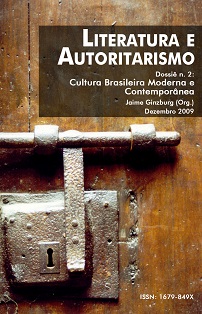Narratives of fear: constructions of otherness in contemporary brazilian cinema O homem do ano
DOI:
https://doi.org/10.5902/1679849X74666Keywords:
Cinema da Retomada, Violence, Media, Criminality, SecurityAbstract
In the final decades of the twentieth century and the initial decade of the twenty-first century, narratives of violence have proliferated within Latin American cinematic production. Films such as the Mexican Amores perros(Iñárritu 2000) and the Brazilian Cidade de Deus(Meirelles 2002) have become both national and international box office blockbusters by projecting the spectacle of violence upon the silver screen. These cinematic works appear to dialogue with newspaper and television headlines that broadcast daily what, at times, seems an ad nauseam repetition of accounts of metropolitan violence. This mediatic episteme in turn creates a discourse of exclusion that then serves to validate the negation of human rights to disenfranchised social groups.Within the visual spectacle of contemporary media and film, what are the narratives that crime films construct and how do they dialogue with social perceptions of violence and its origins? This paper considers how O homem do ano(Fonseca 2003) offers a critique of dominant society’s willingness to forfeit human rights when they pertain to individuals who do not belong to the upper and middle classes. Rather, hegemonic society and the media posit these transgressions as necessary responses to the escalation of violence within the urban sphere. In this manner, Fonseca’s work questions the bourgeoisie plays in the proliferation of said violence as well as the media’s scapegoating of marginal groups within this context.
Downloads
References
ALVES, J. C. S. (1998). Baixada Fluminense: A violência na construção do poder. Departamento De Sociologia. São Paulo, Universidade de São Paulo. Sociologia: 202.
BAUMAN, Z. (2004) Wasted Lives: Modernity and Its Outcasts. Oxford: Oxford University Press.
BEATO, C. (2007)“A mídia define as prioridades da segurança pública.” In: S. Ramos and A Paiva. Mídia e violência: Novas tendeências na cobertura de criminalidade e segurança no Brasil. Rio de Janeiro, IUPERJ.
CALDEIRA, T. (2000) City of Walls: Crime, Segregation, and Citizenship in São Paulo. Berkeley: University of California Press.
COIMBRA, C. M. Bouças. (2001) Operação Rio: O mito das classes perigosas. Um estudo sobre a violência urbana, a mídia impressa e os discursos de segurança pública. Rio de Janeiro: Intertexto.
DELEUZE, G. (1989) Cinema 2: The Time-Image. Minneapolis: U of Minnesota P.
DIKEN, B. e C. Laustsen. (2008) Sociology through the Projector. New York: Routledge.
ENNE, A.L. (2004) Imprensa e Baixada Fluminense: múltiplas representações. Ciberlegenda Número 14-2004. http://www.uff.br/mestcii/enne1.htm
FONSECA, J., et al. (2003) O homem do ano / Man of the Year. DVD. Film Movement; Distributed by RB Media, New York, NY, Prince Frederick, MD.
KAPLAN, E. (1983) Women and Film: Both Sides of the Camera. New York: Methuen.
GASPAR PEREIRA, H. (1996) The Viva Rio Movement: The Struggle for Peace. London: University of London Institute of Latin American Studies.
HERSCHMANN, M. (1997) Abalando os anos 90: funk e hip-hop : globalização, violência e estilo cultural. Rio de Janeiro, Rocco.
MELO, P. (1995) O matador. São Paulo: Companhia das Letras.
MOISÉS, J. (2003) "A New Policy for Brazilian Cinema." Nagib, Lúcia ed. The New Brazilian Cinema. University of Oxford. Centre for Brazilian Studies. New York.
ROTKER, S. e K. Goldman. (2002) Citizens of Fear : Urban Violence in Latin America. New Brunswick: Rutgers University Press.
RAFTER, N. (2000) Shots in the Mirror : Crime Films and Society. New York: Oxford University Press.
SOARES, L. (1993) Criminalidade Urbana E Violência: O Rio De Janeiro No Contexto Internacional. Rio de Janeiro: ISER & FAPERJ.
STAM, R. (1997) Tropical Multiculturalism : A Comparative History of Race in Brazilian Cinema and Culture. Latin America Otherwise. Durham, N.C.: Duke University Press.
TELLES, E. (2004) Race in Another America : The Significance of Skin Color in Brazil. Princeton: Princeton University Press.
VENTURA, Z. (1994) Cidade partida. Companhia das Letras: São Paulo.
Downloads
Published
How to Cite
Issue
Section
License
DECLARAÇÃO DE ORIGINALIDADE E EXCLUSIVIDADE E CESSÃO DE DIREITOS AUTORAIS
Declaro que o presente artigo é original e não foi submetido à publicação em qualquer outro periódico nacional ou internacional, quer seja em parte ou na íntegra. Declaro, ainda, que após publicado pela Literatura e Autoritarismo, ele jamais será submetido a outro periódico. Também tenho ciência que a submissão dos originais à Literatura e Autoritarismo implica transferência dos direitos autorais da publicação digital. A não observância desse compromisso submeterá o infrator a sanções e penas previstas na Lei de Proteção de Direitos Autorais (nº 9610, de 19/02/98).






